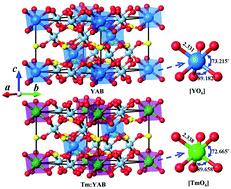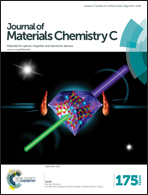Determination of the microstructure, energy levels and magnetic dipole transition mechanism for Tm3+ doped yttrium aluminum borate†
Abstract
Yttrium aluminum borate (YAB) doped with rare-earth ions are promising materials for infrared lasers and self-frequency summing laser systems. The stable crystal forms of YAB doped with rare-earth ions are of great scientific interest. Here, we systematically study the structural evolution of Tm3+ doped YAB, by using an unbiased CALYPSO structure search method in conjunction with first principles calculations. We are able to identify a unique semiconducting phase with P321 space group that reveal Tm3+ ions occupy Y ion sites of octahedral symmetry. The electronic band structure shows an extremely narrow conduction band above the Fermi level of Tm3+ in YAl3(BO3)4, indicating that the impurity Tm3+ ions lead to an insulator to semiconductor transition. The atomic energy structure of the 4f12 configuration of Tm3+ in the YAB has been calculated by a crystal-field theory method, which includes the major electrostatic and spin–orbit interactions as well as various minor contributions, for 4fN tripositive lanthanide ions. Electric dipole induced transitions are calculated to be much stronger than magnetic dipole induced ones in most situations. However, detailed magnetic dipole calculations for individual crystal field levels indicate a large number of strong absorption lines and spontaneous emissions, including many in the visible spectrum and at longer wavelengths that would be an attractive medium for investigating the magnetic portion in the light-matter interactions.


 Please wait while we load your content...
Please wait while we load your content...